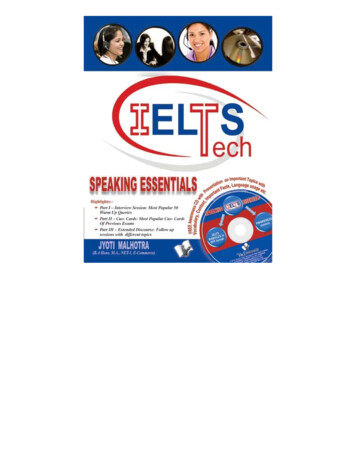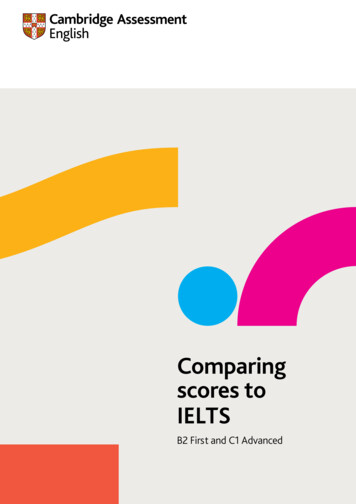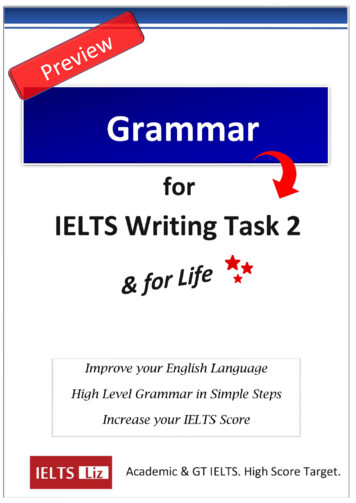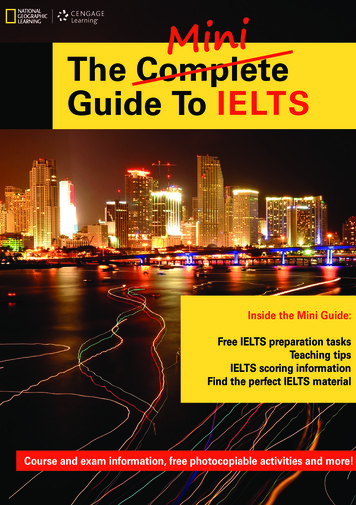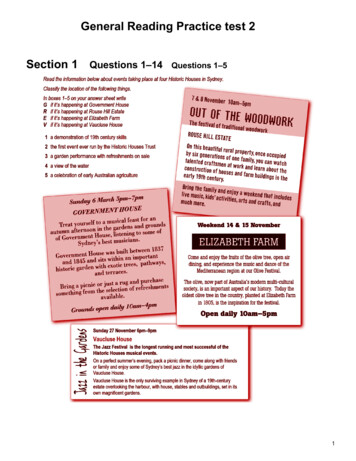
Transcription
General Reading Practice test 2Section 1 Questions 1–14Questions 1–5Ielts-materials.com1
Read the text below and answer Questions 6–12.Ielts-materials.com2
Questions 6–12Complete the summary using the list of words, A–S, below.Write the correct letter, A–S, in boxes 6–12 on your answer sheet.Cycle GuideThis brochure is for people who have recently taken up cycling.For mechanical advice you should go to your nearest cycle shop. They can make sure thatYour bike is .6 . and comfortable. They also have a wide range of accessories forsale, such as specialist gear for .7 . conditions.You need to be aware of the .8 . of the road, as these apply to everyone, not justmotorists. Although .9 . are often allowed to go where many others may not, if youbreak the law, you run the risk of getting .10 . .It pays to belong to the CTC. Members can get help from .11 . and take part in toursand specially arranged .12 . .Ielts-materials.com3
Read the text below and answer Questions 13 and 14.Mitchell CollegeEmergency Fire ProceduresIf you discover a fire, you should sound the fire alarm report the fire to Reception from any of the green phones in the building evacuate (leave) the building and go to your meeting point.If you hear the fire alarm leave the room immediately via the nearest safe exit, shutting the doors behind you do not use the lift do not take any personal belongings assist disabled people and visitors to leave the building go to the arranged meeting point do not return to the building until the fire safety officer has told you it is safe to do so.Questions 13 and 14Choose TWO letters A–F. Write your answers in boxes 13 and 14 on your answer sheet.Which TWO things must you do if the fire alarm goes off?A ring the fire brigadeB close all doors as you leave the buildingC pick up only essential personal belongingsD help anyone in need to get outE check that everyone has gone to the meeting pointF return to the building when the fire alarm stopsIelts-materials.com4
Section 2 Questions 15–27Read the text below and answer Questions 15–19.Ielts-materials.com5
Questions 15 and 16Choose TWO letters, A–F.Write your answers in boxes 15 and 16 on your answer sheet.The list below mentions topics you can cover on the Coffee World course.Which TWO topics are mentioned in the text?A how to run a coffee shopB where coffee comes fromC where to buy the best coffeeD how to choose the best coffee beansE how to select a good coffee machineF how to look after your machineQuestions 17–19Label the diagram.Choose NO MORE THAN TWO WORDS from the text for each answer.Write your answers in boxes 17–19 on your answer sheet.Ielts-materials.com6
Listening PracticeIELTS FeverIELTSFever General Reading 2Read the text below and answer Questions 20–27Ielts-materials.com7
Questions 20–27Complete the sentences below.Choose NO MORE THAN THREE WORDS from the text for each answer.Write your answers in the boxes 20–27 on your answer sheet.(20) The course will equip you to provide care while waiting for (21) You must read if you undertake this course.(22) Everything you learn is backed up by visual material in the form of both (23) The course allows you to assess in three main areas.(24) Working with another student helps you become more confi dent about looking aftera . (25) A knowledge of the will help you understand what each chapter inthe manual is about.(26) A knowledge of the will not count towards your final assessment.(27) Use the to help you remember the information.Section 3 Questions 28–40Read the text below and answer Questions 28–40.Unlocking the history of locks and keys{A} Keys have always represented authority, security, and power. Kings, emperors, courtnobles, and cities and towns across the globe have incorporated the symbol of the key intobanners, coats of arms, and official seals. The delivery of keys to a castle, fortress, or citywas a symbolic event, as is the presentation of the Key-to-the-City today to a visitingdignitary. It was a way of showing people that they were both welcome and trusted.{B} Many centuries ago in ancient Egypt, the importance of the ‘head of the household’ wasdetermined by the number of keys he owned. These were large keys and were carried byslaves on their shoulders. If he had several slaves or key bearers, he was considered to be aman of great wealth and distinction. And in this tradition, through the ages, the lock and itskey have become an intricate part of our culture. Locking up personal property, the keysymbolizes our desire for privacy and security for our possessions.Ielts-materials.com8
{C} The earliest known locks date back well over 3,000 years. They were made of wood andwere large and crude in design, yet their principle of operation was the forerunner of themodern pin-tumbler locks in use today. Since the earliest times, chests were secured withstrong and often very large locks. They were used to protect precious metals,money, jewels, to store clothing, and church vestments, archives and arms, linens and otherhousehold articles, bridal dresses, and even for the burial of important people. Chest lockswere ornamented for household use or were very plain and sturdy for chests that were to betransported. So the design and appearance of a lock usually depended on the use to whichthat lock would be put.{D} Padlocks were known to the ancient Greeks, Romans, Egyptians and other culturesincluding the Chinese, and were particularly favoured because they were portable. It isgenerally believed that the padlock was first used as a ‘travel’ lock to safeguard merchandisefrom thieves along ancient trade routes and seaboards and waterways where commerce wascentred. Brass and iron padlocks found in Europe and the East were popularized by theRomans and the Chinese.{E} Another type of padlock, the push-key padlock, was of simple construction, the bolt beingkept in the locked position by the projection of a spring or springs. To unlock, the springswere compressed or flattened by the key, which freed the bolt and permitted it to slide back.Padlocks were often highly decorated with dragons, horses, dogs and even elephants, andwere presented in pairs as gifts, with congratulatory messages. For better efficiency, letterlocks, otherwise known as combination padlocks, were later developed, which eliminated theneed for an actual key and worked by aligning letters or numbers on revolving disks.Padlocks were used throughout the centuries to lock up prisoners as well as possessions.They were usually made of iron, bronze or brass, and were rough in construction, but had thedisadvantage of being easy to defuse.F Throughout the 14th and 15th centuries in Europe, there was little signifi cant improvementmade in the design of locking mechanisms, although ornamentation became increasinglyimportant. Craftsmen at this time excelled in metalwork and designed and produced locks forgates, doors, chests and cupboards. This was the age of the 'Masterpiece’ lock, that had tobe designed and produced as one-of-a-kind by a journeyman(1) locksmith, in order to qualifyhim as a Master. Masterpiece locks, which were never actually used on a door, were oftendisplayed without covers to show the component parts of the mechanisms, their functions,the decoration and the method of assembly.G During the era of the Renaissance in the 15th and 16th centuries in Europe, masterlocksmiths were inspired to produce the most intricate and the finest ornamental locks of alltime. This was the period when iron craftsmen and lock artisans were highly sought after andbecame internationally famous. They excelled in the forging, embossing, engraving, andetching of metals, and were invited to make locks and keys for many of the great courts ofEurope.Ielts-materials.com9
Beating the burglarsWhen lock-picking(2) became prevalent in the 18th century, the inventor met the challenge ofconfounding the burglar with increasingly complicated locking mechanisms. Among the newimprovements were keys with changeable bits, as well as alarm bells and what were knownas ‘puzzle’ padlocks. These early puzzle padlocks had from three to seven rings ofcharacters or letters which released the lock when properly aligned. Dial locks were similar inoperation, and both types were set to be unlocked by words or patterns of numbers knownonly to the owners or responsible persons.The introduction of digital technology in the late 20th century revolutionised the science oflocks and security systems. But despite the advances made in this field, most of us still relyon conventional keys to lock our front doors or start the car, possibly because we prefer themechanical satisfaction of turning a key to remembering a security number.(1)apprentice, someone who is learning his/her trade(2)the art of opening a lock without a key, usually illegallyQuestions 28–34The text has seven paragraphs, A–G.Which paragraph contains the following information?Write the correct letter, A–G, in boxes 28–34 on your answer sheet.(28) the reason why a certain lock was used to protect goods for sale(29) an explanation of how a particular lock works(30) examples of the relationship between form and function(31) a time when locksmiths were in big demand(32) reference to an ancient ceremony(33) how certain lock-making skills were tested(34) the use of keys as a measure of a person’s social statusIelts-materials.com10
Questions 35 and 36Choose the correct letter, A, B, C or D.Write your answers in boxes 35 and 36 on your answer sheet.{35} According to the writer, early padlocks were popular because they were(A) made of wood.(B) extremely secure.(C) easily transported.(D) common to many cultures.{36} What does the writer say about Masterpiece locks?(A) They were used to demonstrate design features.(B) They were made to lock up small items only.(C) They were made for the royal families of Europe.(D) They were produced to last for centuries.Questions 37–40Complete the notes below.Choose NO MORE THAN TWO WORDS from the text for each answer.Write your answers in boxes 37–40 on your answer sheet.Anti-burglar devicesSecurity mechanisms have included: keys with changeable bits (37) puzzle padlocks (38) In recent years, alternative methods of security have been madepossibleby (39) However, people continue to prefer (40) Click here to GET More Practice MaterialIelts-materials.com11
Ielts-materials.com. Q u esti o n s 6-12 Complete the summary using the list of words, A-S, below. Write the correct letter, A-S , in boxes 6-12 on your answer sheet. . Listening Practice IELTS Fever IELTSFever General Reading 2 T Ielts-materials.com. Q u esti o n s 20-27



